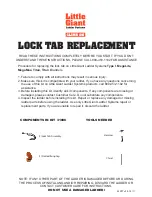
VI.
TROUBLE SHOOTING
All units are tested after final assembly to ensure proper operation and adjustment. No further
adjustments should be required unless excess vibration is noted (see VI. D., page 9).
A. Actuator "Creeping Down"
An indicator light may be installed in the cab of your vehicle to warn the driver when the System is
out of the stored position. If this light comes on while the vehicle is in motion, it may be an indicator
that one of the electric actuators is "creeping down". The actuator will not drop suddenly but the driver
should keep an eye on the System until he reaches his destination. Then the switch may be activated to
retract the System to the stored position.
Under certain road conditions, the frequency of vibrations may cause the friction brake within the
electric actuator to slip. This in turn may allow the motor to turn and the worm gear to retract or "back
drive". The same problem may occur when a hard sleeve is mounted above the ladders and/or hard
sleeves.
If your System "creeps down", we suggest you add the manual locking system (Figure 24, page 33)
or electric locking system (Figure 27, page 36) to your System (see III. G. & H., page 3).
B. Ladder Wider Than Ladder Support
If the proper ladder combination is specified at the time of ordering, this problem should not occur.
The standard support channel (item 54, page 15) is 25-1/4" long. We can also provide a longer support
channel (part number 3097-105-155) which is 27" long. See Chart 3, page 18, for combinations
requiring the 27" long channel. Spacer set (part number 3097-250-000) must be ordered with these
combinations.
C. One Actuator Running Two Or More Seconds Slower Than The Other
All actuators are timed, under load, at the factory with the times recorded. We match up electric
actuators with as close to equal times as possible when assembling a QUIC-LIFT System. When one
actuator is running more than two seconds behind the other, it is normally due to some type of
resistance in the wiring system. Check all wire connections to make sure they are secure. Make sure to
ratchet both actuators at the end of each up and down cycle. If they are still greatly out of sync, after
checking the wiring and ratcheting units at the end of each cycle, you may switch the actuators to
confirm if the problem is in the wiring system. After removing the ladders, remove the nut/bolt
assembly (items 10, 16 and 42, page 15) to remove the actuator. Switch the two actuators and
reassemble. If the rear unit actuator was originally running slower and this unit is still running slower
then the problem is in the wiring. If the problem switches from rear unit actuator running slower to front
unit running slower after the switch, then the problem may be the actuator.
-8-
Содержание QUIC-LIFT LAS-775
Страница 11: ...11 FIGURE 1 ACTUATOR RETAINER ADJUSTMENT See Section VI D 1 FIGURE 2 ADJUSTMENT STOP See Section VI D 2...
Страница 21: ...21 FIGURE 7 COMMON INSTALLATION USING STIFFENING BACKING PLATE...
Страница 26: ...FIGURE 14 QUIC STRAP SYSTEM TO RETAIN HARD SLEEVE FIGURE 15 HOSE TRAY SUPPORT WITH HOSE TRAY 26...
Страница 40: ...40 FIGURE 31 LAS ____ COMPONENTS See Chart 1 Parts List Page 14 and Figure 3 Drawings Page 15...
Страница 42: ...42 This page intentionally left blank...





























